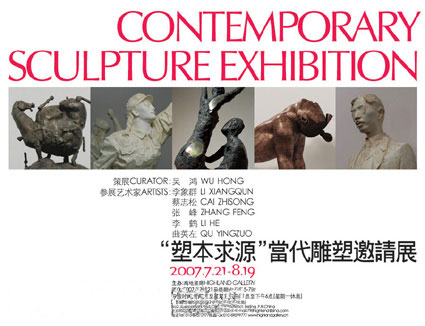
• “塑本求源”当代雕塑邀请展
•策划人:吴鸿
•参展艺术家:李象群 蔡志松 张峰 李鹤 曲英左
•展期:2007年7月21日至8月19日
•酒会: 2007年7月21日星期六下午17-19时
•主办:北京高地画廊
我们现在来谈的“雕塑”实际上是特指自20世纪初叶传入中国的以西方团块式造型为特征的造型样式,它与中国传统的以线带面的造型体系有着本质的区别。中国传统雕塑的这种造型方式在20世纪以后,除了在民间工艺和寺庙造像中还有部分保留外,已经不再占据立体造型艺术的主流。而即使是在民间工艺和寺庙造像中,也受到了西方近代艺术教育体系的影响,造型方式中越来越更多地融入了团块性的塑造因素。所以,不管是在中国近代意义上的学院式艺术教育体系中,还是20世纪以后的主流艺术创作中,以团块式造型为特征的雕塑语言体系一直占据了重要的位置。
上述的判断是一个粗略的线索,实际上是20世纪雕塑语言的发展过程中,不断受到了来自于社会、政治,以及文化等各方面的影响,使雕塑语言的发展呈现出了复杂的形态。
众所周知,在雕塑作品的创作过程中,会受到材料和后期制作工艺的制约。传统雕塑因为大多以泥塑木胎工艺和小型木石雕刻为主,而不太会涉及到复杂的机械、铸造等加工制作工艺。而在20世纪初叶雕塑刚刚传入的时候,因为中国在当时工业水平的落后,无法为雕塑提供必要的制作工艺基础,这样,早期的雕塑家们的创作多以小型架上为主,作品体积结构的组织形态也多以室内光线为光源条件。在这个时期中,虽然中国的雕塑创作很少有重要的传世之作流传下来,但是在我们现在能见到的为数不多的资料中,仍可以发现明显的欧化传统的余流。
1949年之后,沿袭前苏联的艺术教化、宣传传统,雕塑开始有机会走向室外接受外光的考验。同时,雕塑语言也开始为了适应政治宣传的目的而发生了第一次的“异化”。及至文革前及文革时期,这种政治热情使雕塑语言发展成了一种夸张的宣传画式的视觉效果。其原因有三。其一,程式化的造型和构图模式形成了形式语言的单一;其二,“高昂”的政治热情必须要有一种夸张、强化的造型方式与之相适应;第三,受当时的经济及工艺水平的制约,只能大量使用水泥作为替代性材料,而这种材料又只能进行大块面的简约塑造,在这样的前提下,雕塑只能采取了一种建筑式的体面语言来强化视觉效果。由此,雕塑成为了一种立体的政治“宣传画”。
1980年代之后,受西方当代艺术的影响,一股探求新的语言方式的风气开始蔓延全国,其中装置作为一种国人还没有接触过的语言形式也在艺术界流行起来,而雕塑因为材料和三维空间训练的缘故,在这个时期开始出现了“装置化”的语言倾向。这是雕塑语言的第二次异化现象。甚至还有这样的理解,认为装置比雕塑更“当代”。这其实是一种简单的线性思维的表现。装置本质上与雕塑是完全不同的语言形态,虽然两者在占有三维空间和采用硬质材料方面有一定的同一之处,但是装置是一个多种材料“集成”的概念,其构思作品是“加法”的方式。作品在构思、制作和解读的过程中是一种“流动”的过程。而雕塑则是一个凝固的瞬间,其处理空间的方式是一种内敛的体验。
雕塑语言装置化的结果是,语言外延的不断泛化导致了“集成”代替了“塑造”,材料本身的意义代替了造型的意义。
而作为一种上溯“源头”的方式,高地画廊此展仅仅是提出了一个话题,提出了一个思路,而并不是试图“解决”什么问题。因为这个话题也只有是雕塑界本身才能产生意义,而并没有什么厚此薄彼的意图。同时,此展也是为下一个探讨雕塑语言泛化问题的展览做铺垫,所以,从这个意义上来说,这个展览所展出的作品基本上是本着能体现出某种“原教旨”意义上的形态,来说明雕塑语言的回归。
2007年6月26日
Dissimilation’ and ‘Regression’ of Sculpting
Text by Wu Hong
What we have discussed about ‘statuary’ nowadays is actually, since it passed on to China in early 20th century, pointed to the typical style of traditional western corposhaping which has an essential distinction to traditional Chinese form of using lines for making shapes. The way of ancient Chinese sculpting, after entering 20th century, has unlikely held an important position in mainstream of art unless it’s being retained in folk handicraft and temple statues, in which also show the influence of modern western system of art education. Therefore, whatever academic education system or among the mainstream art creation after 20th century is, the form of corposhaping in sculpting has occupied an important place in the field of sculpture.
The judgment of aforementioned is only a rough clue. In reality, during the developing process of sculpting in last century, the style of sculpture had constantly interrupted in every aspect by society, politic and culture which also brought up the complex forms into the expression of sculpting.
It is common knowledge that, during the course of creating sculpture, it is always restricted by materials and later stage of making technology. Traditional statues were most carved in wood or stone or moulded in clay and could hardly ever involve with complicated machining or casting. But, while the sculpture entered China in early 20th century, the backwardness of its industrial level couldn’t supply its necessary manufacturing form so that what the sculptors from early days had created were mostly pieces of statuettes with an indoor light as the main illuminant. For the duration of that time, although the sculpture creation in China had no particular pieces of works been handed down from but, through the limited reference materials left, we also could discover the trace of how it had been westernized.
After year 1949 when People’s Republic of China founded, following former the Soviet Union’s education system of art and dissemination, sculpting had a chance to move to outdoor for trial. In addition, the expression of sculpture had had the first time of dissimilation only for suiting the needs of political propaganda. Until, before and during the culture revolution, the enthusiasm for politic had made the form of sculpting become a kind of artistic exaggeration in the vision of picture poster, in which there were three things accounted for the occurrence: firstly, the stylized shapes and composition formed an unitary expression; secondly, to be in ‘high spirits’ for politic must have an exaggerated and strengthened way of expression to suit with; thirdly, it was restricted by then economy and technology level so as to have to use plenty of cement as substitute, in which had only modeled on a big scale briefly. Under such presupposition, to sculpture had adopted the method of architecture to intensify visual impressions. Therefore, statuary had turn into a three-dimensional political picture poster.
When time passed into 1980s, by the influence of west contemporary art, to established practice in seeking for new form of expression had spread all over the country, among which the installation art became popular as an unfamiliar artistic form at art circle, and due to the materials and three-dimensional training sculpture had a tendency to be installed. This was the second time of dissimilation. And there was even such comprehension of which one took installation art much more ‘modern’ than statuary. This is a factor of linear mode of thinking. Art of installation is intrinsically a different form of artistic expression to sculpting, though both of them have similarities in occupying three-dimensional and using rigid materials. In actual conception, installation is integrated of various materials which composed in a way of addition. And in the course of composition, creating and decoding of works are often a process on the move. To sculpture, it is a moment of solidifying, in which is likely an internal experience of oneself in handling space.
The outcome of being installed sculpture is the style of artistic manifestation in generality that result in ‘integrated materials’ substitute for ‘modeling’. The meaning of material itself also substitutes for the purpose of shaping.
As a mode of tracing to the source, this exhibition in Highland Gallery only raises a topic and puts forward a train of thought, and having no attempt to ‘solve’ anything out. Because this subject has meaning only to sculpting circle, in which has no intention to favour one and be prejudiced against the other. Simultaneously, the exhibition is too the foreshadowing for approaching the subject of generality of the form of sculpting. Therefore, the displayed works in this show basically embody a kind of foundamental significance which reflects the resurgence of the artistic expression of sculpture.